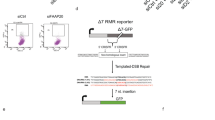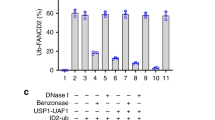Abstract
The 15 known Fanconi anemia proteins cooperate in a pathway that regulates DNA interstrand cross-link repair. Recent studies indicate that the Fanconi anemia pathway also controls Rev1-mediated translesion DNA synthesis (TLS). We identified Fanconi anemia–associated protein (FAAP20), an integral subunit of the multisubunit Fanconi anemia core complex. FAAP20 binds to FANCA subunit and is required for stability of the complex and monoubiquitination of FANCD2. FAAP20 contains a ubiquitin-binding zinc finger 4 domain and binds to the monoubiquitinated form of Rev1. FAAP20 binding stabilizes Rev1 nuclear foci and promotes interaction of the Fanconi anemia core with PCNA–Rev1 DNA damage bypass complexes. FAAP20 therefore provides a critical link between the Fanconi anemia pathway and TLS polymerase activity. We propose that the Fanconi anemia core complex regulates cross-link repair by channeling lesions to damage bypass pathways and preventing large DNA insertions and deletions.
This is a preview of subscription content, access via your institution
Access options
Subscribe to this journal
Receive 12 print issues and online access
$189.00 per year
only $15.75 per issue
Buy this article
- Purchase on Springer Link
- Instant access to full article PDF
Prices may be subject to local taxes which are calculated during checkout






Similar content being viewed by others
References
Joenje, H. & Patel, K.J. The emerging genetic and molecular basis of Fanconi anaemia. Nat. Rev. Genet. 2, 446–457 (2001).
Kee, Y. & D'Andrea, A.D. Expanded roles of the Fanconi anemia pathway in preserving genomic stability. Genes Dev. 24, 1680–1694 (2010).
Ciccia, A. et al. Identification of FAAP24, a Fanconi anemia core complex protein that interacts with FANCM. Mol. Cell 25, 331–343 (2007).
Smogorzewska, A. et al. Identification of the FANCI protein, a monoubiquitinated FANCD2 paralog required for DNA repair. Cell 129, 289–301 (2007).
Joo, W. et al. Structure of the FANCI–FANCD2 complex: insights into the Fanconi anemia DNA repair pathway. Science 333, 312–316 (2011).
Yamamoto, K.N. et al. Involvement of SLX4 in interstrand cross-link repair is regulated by the Fanconi anemia pathway. Proc. Natl. Acad. Sci. USA 108, 6492–6496 (2011).
Cybulski, K.E. & Howlett, N.G. FANCP/SLX4: A Swiss army knife of DNA interstrand crosslink repair. Cell Cycle 10, 1757–1763 (2011).
Huang, M. & D'Andrea, A.D. A new nuclease member of the FAN club. Nat. Struct. Mol. Biol. 17, 926–928 (2010).
Bienko, M. et al. Ubiquitin-binding domains in Y-family polymerases regulate translesion synthesis. Science 310, 1821–1824 (2005).
Hofmann, K. Ubiquitin-binding domains and their role in the DNA damage response. DNA Repair (Amst.) 8, 544–556 (2009).
Knipscheer, P. et al. The Fanconi anemia pathway promotes replication-dependent DNA interstrand cross-link repair. Science 326, 1698–1701 (2009).
Papadopoulo, D., Guillouf, C., Mohrenweiser, H. & Moustacchi, E. Hypomutability in Fanconi anemia cells is associated with increased deletion frequency at the HPRT locus. Proc. Natl. Acad. Sci. USA 87, 8383–8387 (1990).
Mirchandani, K.D. & D'Andrea, A.D. The Fanconi anemia/BRCA pathway: a coordinator of cross-link repair. Exp. Cell Res. 312, 2647–2653 (2006).
Kannouche, P.L., Wing, J. & Lehmann, A.R. Interaction of human DNA polymerase eta with monoubiquitinated PCNA: a possible mechanism for the polymerase switch in response to DNA damage. Mol. Cell 14, 491–500 (2004).
Lehmann, A.R. et al. Translesion synthesis: Y-family polymerases and the polymerase switch. DNA Repair (Amst.) 6, 891–899 (2007).
Waters, L.S. et al. Eukaryotic translesion polymerases and their roles and regulation in DNA damage tolerance. Microbiol. Mol. Biol. Rev. 73, 134–154 (2009).
Niedzwiedz, W. et al. The Fanconi anaemia gene FANCC promotes homologous recombination and error-prone DNA repair. Mol. Cell 15, 607–620 (2004).
Nelson, J.R., Lawrence, C.W. & Hinkle, D.C. Deoxycytidyl transferase activity of yeast REV1 protein. Nature 382, 729–731 (1996).
Mirchandani, K.D., McCaffrey, R.M. & D'Andrea, A.D. The Fanconi anemia core complex is required for efficient point mutagenesis and Rev1 foci assembly. DNA Repair (Amst.) 7, 902–911 (2008).
Hicks, J.K. et al. Differential roles for DNA polymerases eta, zeta, and REV1 in lesion bypass of intrastrand versus interstrand DNA cross-links. Mol. Cell. Biol. 30, 1217–1230 (2010).
Huang, T.T. & D'Andrea, A.D. Regulation of DNA repair by ubiquitylation. Nat. Rev. Mol. Cell Biol. 7, 323–334 (2006).
Bergink, S. & Jentsch, S. Principles of ubiquitin and SUMO modifications in DNA repair. Nature 458, 461–467 (2009).
Yang, K., Moldovan, G.L. & D'Andrea, A.D. RAD18-dependent recruitment of SNM1A to DNA repair complexes by a ubiquitin-binding zinc finger. J. Biol. Chem. 285, 19085–19091 (2010).
Guo, C. et al. REV1 protein interacts with PCNA: significance of the REV1 BRCT domain in vitro and in vivo. Mol. Cell 23, 265–271 (2006).
Guo, C. et al. Ubiquitin-binding motifs in REV1 protein are required for its role in the tolerance of DNA damage. Mol. Cell. Biol. 26, 8892–8900 (2006).
Wood, A., Garg, P. & Burgers, P.M.J. A ubiquitin-binding motif in the translesion DNA polymerase Rev1 mediates its essential functional interaction with ubiquitinated proliferating cell nuclear antigen in response to DNA damage. J. Biol. Chem. 282, 20256–20263 (2007).
Hershko, A. & Rose, I.A. Ubiquitin-aldehyde: a general inhibitor of ubiquitin-recycling processes. Proc. Natl. Acad. Sci. USA 84, 1829–1833 (1987).
Parris, C.N. & Seidman, M.M. A signature element distinguishes sibling and independent mutations in a shuttle vector plasmid. Gene 117, 1–5 (1992).
Choi, J.-H. & Pfeifer, G.P. The role of DNA polymerase eta in UV mutational spectra. DNA Repair (Amst.) 4, 211–220 (2005).
Deans, A.J. & West, S.C. DNA interstrand crosslink repair and cancer. Nat. Rev. Cancer 11, 467–480 (2011).
Bunting, S.F. & Nussenzweig, A. Dangerous liaisons: Fanconi anemia and toxic nonhomologous end joining in DNA crosslink repair. Mol. Cell 39, 164–166 (2010).
Moldovan, G.-L., Pfander, B. & Jentsch, S. PCNA, the maestro of the replication fork. Cell 129, 665–679 (2007).
Ross, A.-L., Simpson, L.J. & Sale, J.E. Vertebrate DNA damage tolerance requires the C-terminus but not BRCT or transferase domains of REV1. Nucleic Acids Res. 33, 1280–1289 (2005).
Arakawa, H. et al. A Role for PCNA ubiquitination in immunoglobulin hypermutation. PLoS Biol. 4, e366 (2006).
Song, I.Y. et al. Rad18-mediated translesion synthesis of bulky DNA adducts is coupled to activation of the Fanconi anemia DNA repair pathway. J. Biol. Chem. 285, 31525–31536 (2010).
Williams, S.A., Longerich, S., Sung, P., Vaziri, C. & Kupfer, G.M. The E3 ubiquitin ligase RAD18 regulates ubiquitylation and chromatin loading of FANCD2 and FANCI. Blood 117, 5078–5087 (2011).
Park, H.K., Wang, H., Zhang, J., Datta, S. & Fei, P. Convergence of Rad6/Rad18 and Fanconi anemia tumor suppressor pathways upon DNA damage. PLoS ONE 5, e13313 (2010).
Geng, L., Huntoon, C.J. & Karnitz, L.M. RAD18-mediated ubiquitination of PCNA activates the Fanconi anemia DNA repair network. J. Cell Biol. 191, 249–257 (2010).
Palle, K. & Vaziri, C. Rad18 E3 ubiquitin ligase activity mediates Fanconi anemia pathway activation and cell survival following DNA topoisomerase 1 inhibition. Cell Cycle 10, 1625–1638 (2011).
Keaton, M.A. & Dutta, A. Rad18 emerges as a critical regulator of the Fanconi anemia pathway. Cell Cycle 10, 2414–2415 (2011).
Howlett, N.G., Taniguchi, T., Durkin, S.G., D'Andrea, A.D. & Glover, T.W. The Fanconi anemia pathway is required for the DNA replication stress response and for the regulation of common fragile site stability. Hum. Mol. Genet. 14, 693–701 (2005).
Howlett, N.G., Harney, J.A., Rego, M.A., Kolling, F.W. & Glover, T.W. Functional interaction between the Fanconi anemia D2 protein and proliferating cell nuclear antigen (PCNA) via a conserved putative PCNA interaction motif. J. Biol. Chem. 284, 28935–28942 (2009).
Yang, K. et al. Regulation of the Fanconi anemia pathway by a SUMO-like delivery network. Genes Dev. 25, 1847–1858 (2011).
Wang, A.T. et al. Human SNM1A and XPF-ERCC1 collaborate to initiate DNA interstrand cross-link repair. Genes Dev. 25, 1859–1870 (2011).
Kim, J.M., Kee, Y., Gurtan, A. & D'Andrea, A.D. Cell cycle-dependent chromatin loading of the Fanconi anemia core complex by FANCM/FAAP24. Blood 111, 5215–5222 (2008).
Acknowledgements
We thank L.A. Moreau for chromosome aberration assay and K. Hofmann (Miltenyi Biotec), I. Dikic (Institute of Biochemistry II), A.R. Lehmann (University of Sussex), and E.H.-Y. Cheng (Memorial Sloan-Kettering Cancer Center) for reagents. We also thank members of D'Andrea laboratory for valuable input and helpful discussions. H.K. is a recipient of the Leukemia and Lymphoma Society Career Development Fellowship. K.Y is a Harvard University Presidential Scholar. This work was supported by grants RO1DK43889 and RO1HL52725 to A.D.D.
Author information
Authors and Affiliations
Contributions
H.K. and A.D.D. designed and interpreted experiments. H.K. and D.D. conducted experiments. K.Y. carried out bioinformatics analysis. H.K. and A.D.D. wrote the manuscript. A.D.D. directed the project.
Corresponding author
Ethics declarations
Competing interests
The authors declare no competing financial interests.
Supplementary information
Supplementary Text and Figures
Supplementary Figures 1–6 and Supplementary Methods (PDF 1572 kb)
Rights and permissions
About this article
Cite this article
Kim, H., Yang, K., Dejsuphong, D. et al. Regulation of Rev1 by the Fanconi anemia core complex. Nat Struct Mol Biol 19, 164–170 (2012). https://doi.org/10.1038/nsmb.2222
Received:
Accepted:
Published:
Issue Date:
DOI: https://doi.org/10.1038/nsmb.2222
This article is cited by
-
Fanconi anemia associated protein 20 (FAAP20) plays an essential role in homology-directed repair of DNA double-strand breaks
Communications Biology (2023)
-
Fanconi anemia: current insights regarding epidemiology, cancer, and DNA repair
Human Genetics (2022)
-
The emergence of a unified mechanism in the Fanconi anemia pathway
Genome Instability & Disease (2021)
-
Fanconi anemia pathway and its relationship with cancer
Genome Instability & Disease (2021)
-
Intrinsic adriamycin resistance in p53-mutated breast cancer is related to the miR-30c/FANCF/REV1-mediated DNA damage response
Cell Death & Disease (2019)



